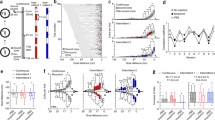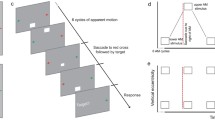Abstract
Anticipation and prediction have been identified as key functions of many brain areas facilitating recognition, perception, and planning. In this chapter we present a hierarchical neurocomputational model in which feedback, effectively predicting or anticipating task-relevant features, leads to sustained inattentional blindness. A psychological experiment on sustained inattentional blindness in human subjects is simulated to provide visual input to a hierarchy of Echo State Networks. Other parts of the model receive input relevant to tracking the attended object and also detecting the unexpected object, feedback from which is then used to simulate engagement in the task and compared to results obtained without feedback, simulating passive observation. We find a significant effect of anticipation enhancing performance at the task and simultaneously degrading detection of unexpected features, thereby modelling the sustained inattentional blindness effect. We therefore suggest that anticipatory / predictive mechanisms are responsible for sustained inattentional blindness.
Preview
Unable to display preview. Download preview PDF.
Similar content being viewed by others
References
Morse, A.F.: Neural Models of Prediction and Sustained Inattentional Blindness. In: NCPW11 the Neural Computation and Psychology Workshop. World Scientific, Oxford (in press)
Morse, A., Lowe, R., Ziemke, T.: Manipulating Space: Modelling the Role of Transient Dynamics in Inattentional Blindness. Connection Science (accepted)
Downing, K.L.: Neuroscientific implications for situated and embodied artificial intelligence. Connection Science 19, 75–104 (2007)
Downing, K.L.: Predictive models in the brain. Connection Science (in press)
Fleischer, J.G.: Neural correlates of anticipation in cerebellum, basal ganglia, and hippocampus. In: Butz, M.V., Sigaud, O., Pezzulo, G., Baldassarre, G. (eds.) ABiALS 2006. LNCS, vol. 4520, pp. 19–34. Springer, Heidelberg (2007)
Hawkins, J., Blakeslee, S.: On Intelligence. Times Books (2004)
Gallese, V., Lakoff, G.: The brain’s concepts: The role of the sensory-motor system in reason and language. Cognitive Neuropsychology 22, 455–479 (2005)
Rumelhart, D.E., McClelland, J.L.: The PDP Research Group, vol. 2 (1986)
Hebb, D.O.: The Organization of Behavior: A Neuropsychological Theory. John Wiley & Sons, Chichester (1949)
Karmiloff-Smith, A.: Why Babies’ Brains Are Not Swiss Army Knives. In: Rose, H., Rose, S. (eds.) Alas, poor Darwin, pp. 144–156. Jonathan Cape, London (2000)
Sharma, J., Angelucci, A., Sur, M.: Induction of visual orientation modules in auditory cortex. Nature 404, 841–847 (2000)
Mountcastle, V.B.: An Organizing Principle for Cerebral Function: The Unit Model and the Distributed System. In: Edelman, Mountcastle (eds.) The Mindful Brain. MIT Press, Cambridge (1978)
Noë, A.: Action in Perception. MIT Press, Cambridge (2004)
Morse, A., Ziemke, T.: Cognitive Robotics, Enactive Perception, and Learning in the Real World. In: CogSci 2007 - The 29th Annual Conference of the Cognitive Science Society, pp. 485–490. Erlbaum, New York (2007)
Maturana, H., Varela, F.: The tree of knowledge, revised edition. Shambhala, Boston (1992)
Gehringer, W.L., Engel, E.: Effect of ecological viewing conditions on the Ames’ distorted room illusion. Journal of Experimental Psychology: Human Perception and Performance 12, 181–185 (1986)
Clark, A., Grush, R.: Towards a Cognitive Robotics. Adaptive Behavior 7, 5 (1999)
Grush, R.: The emulation theory of representation: Motor control, imagery, and perception. Behavioral and Brain Sciences 27, 377–396 (2004)
Hesslow, G.: Conscious thought as simulation of behaviour and perception. Trends in Cognitive Sciences 6, 242–247 (2002)
Kunde, W., Elsner, K., Kiesel, A.: No anticipation–no action: the role of anticipation in action and perception. Cognitive Processing 8, 71–78 (2007)
Gibson, J.J.: The Ecological Approach to Visual Perception. Houghton Mifflin, Boston (1979)
Barsalou, L., Breazeal, C., Smith, L.: Cognition as coordinated non-cognition. Cognitive Processing 8, 79–91 (2007)
Fodor, J.: The language of thought. Harvard University Press, Cambridge (1975)
Fodor, J., Pylyshyn, Z.: Connectionism and cognitive architecture: A critical analysis. Connections and Symbols, 3–71 (1988)
Bruce, V., Burton, A.M., Craw, I.: Modelling face recognition. Philosophical Transactions of the Royal Society, B 335, 121–128 (1992)
Burton, A.M., Bruce, V.: Naming Faces and Naming Names: Exploring an Interactive Activation Model of Person Recognition. Memory for Proper Names (1993)
Bruce, V., Burton, M., Carson, D., Hanna, E., Mason, O.: Repetition Priming of Face Recognition. Attention and Performance XV: Conscious and Nonconscious Information Processing (1994)
Morse, A.F.: Psychological ALife: Bridging The Gap Between Mind And Brain; Enactive Distributed Associationism & Transient Localism. In: Cangelosi, A., Bugmann, G., Borisyuk, R. (eds.) Modeling Language, Cognition, and Action: Proceedings of the ninth conference on neural computation and psychology, pp. 403–407. World Scientific, Singapore (2005)
Morse, A.F.: Cortical Cognition: Associative Learning in the Real World. D Phil. Thesis, Department of Informatics, University of Sussex, UK (2006)
Burton, A.M., Bruce, V., Hancock, P.J.B.: From pixels to people: A model of familiar face recognition. Cognitive Science 23, 1–31 (1999)
Morse, A.F.: Autonomous Generation of Burton’s IAC Cognitive Models. In: Schmalhofer, Young, Katz (eds.) EuroCogSci 2003, The European Cognitive Science Conference. LEA Press (2003)
Page, M.: Connectionist modelling in psychology: A localist manifesto. Behavioral and Brain Sciences 23, 443–467 (2001)
Harvey, I.: Untimed and Misrepresented: Connectionism and the Computer Metaphor. AISB Quarterly 96, 20–27 (1996)
Kirsh, D.: From connectionist theory to practice. In: Connectionism: Theory and practice. Oxford Univ. Press, New York (1992)
Clark, A., Thornton, C.: Trading spaces: Computation, representation, and the limits of uninformed learning. Behavioral and Brain Sciences 20, 57–66 (1997)
O’Regan, K., Noë, A.: A sensorimotor account of visual perception and consciousness. Behavioral and Brain Sciences 24, 939–1011 (2001)
Morse, A.F., Ziemke, T.: Cognitive Robotics, Enactive Perception, and Learning in the Real World. In: CogSci 2007 - The 29th Annual Conference of the Cognitive Science Society. Erlbaum, New York (2007)
Simons, D.J., Chabris, C.F.: Gorillas in our midst: Sustained inattentional blindness for dynamic events. Perception 28, 1059–1074 (1999)
Rensink, R.A., O’Regan, J.K., Clark, J.: To see or not to see: the need for attention to perceive changes in scenes. Psychological Science 8(5), 368–373 (1997)
Simons, D., Chabris, C.: Gorillas in our midst: Sustained inattentional blindness for dynamic events. Perception 28, 1059–1074 (1999)
Most, S., Simons, D., Scholl, B., Jimenez, R., Clifford, E., Chabris, C.: How Not to Be Seen: The Contribution of Similarity and Selective Ignoring to Sustained Inattentional Blindness. Psychological Science 12, 9–17 (2001)
Most, S., Scholl, B., Clifford, E., Simons, D.: What you see is what you set: Sustained inattentional blindness and the capture of awareness. Psychological Review 112, 217–242 (2005)
Koivisto, M., Revonsuo, A.: The role of unattended distractors in sustained inattentional blindness. Psychological Research 72, 39–48 (2008)
Most, S.B., Simons, D.J., Scholl, B.J., Jimenez, R., Clifford, E., Chabris, C.F.: How Not to Be Seen: The Contribution of Similarity and Selective Ignoring to Sustained Inattentional Blindness. Psychological Science 12, 9–17 (2001)
Markram, H., Wang, Y., Tsodyks, M.: Differential signaling via the same axon of neocortical pyramidal neurons. National Acad. Sciences 95, 5323–5328 (1998)
Gupta, A., Silberber, G., Toledo-Rodriguez, M., Wu, C.Z., Wang, Y., Markram, H.: Organizing principles of neocortical microcircuits. Cellular and Molecular Life Sciences (2002)
Shepherd, G.M.: A basic circuit for cortical organization. Perspectives in Memory Research, 93–134 (1988)
Douglas, R.J., Martin, K.A.C.: Neuronal Circuits of the Neocortex. Annu. Rev. Neurosci. 27, 419–451 (2004)
Maass, W., Natschlager, T., Markram, H.: Real-Time Computing Without Stable States: A New Framework for Neural Computation Based on Perturbations. Neural Computation 14, 2531–2560 (2002)
Maass, W., Natschlager, T., Markram, H.: A Model for Real-Time Computation in Generic Neural Microcircuits. Advances in Neural Information Processing Systems 15 (2003)
Maass, W., Natschlager, T., Markram, H.: Computational models for generic cortical microcircuits. Computational Neuroscience: A Comprehensive Approach (2003)
Jaeger, H.: The echo state approach to analysing and training recurrent neural networks. German National Institute for Computer Science (2001)
Jaeger, H.: Short term memory in echo state networks. German National Institute for Computer Science (2001)
Jaeger, H.: Tutorial on Training Recurrent Neural Networks, Covering BPTT, RTRL, EKF and the echo State Network Approach. GMD-Forschungszentrum Informationstechnik (2002)
Jaeger, H.: Adaptive Nonlinear System Identification with Echo State Networks. Neural Information Processing Systems, NIPS (2002)
Kohonen, T.: The self-organizing map. Neurocomputing 21, 1–6 (1998)
Author information
Authors and Affiliations
Editor information
Editors and Affiliations
Rights and permissions
Copyright information
© 2009 Springer-Verlag Berlin Heidelberg
About this paper
Cite this paper
Morse, A.F., Lowe, R., Ziemke, T. (2009). A Neurocomputational Model of Anticipation and Sustained Inattentional Blindness in Hierarchies. In: Pezzulo, G., Butz, M.V., Sigaud, O., Baldassarre, G. (eds) Anticipatory Behavior in Adaptive Learning Systems. ABiALS 2008. Lecture Notes in Computer Science(), vol 5499. Springer, Berlin, Heidelberg. https://doi.org/10.1007/978-3-642-02565-5_9
Download citation
DOI: https://doi.org/10.1007/978-3-642-02565-5_9
Publisher Name: Springer, Berlin, Heidelberg
Print ISBN: 978-3-642-02564-8
Online ISBN: 978-3-642-02565-5
eBook Packages: Computer ScienceComputer Science (R0)




